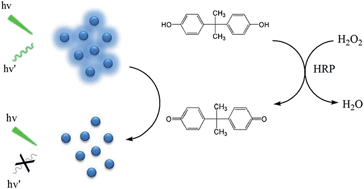Highly sensitive detection of bisphenol A in food packaging based on graphene quantum dots and peroxidase
Abstract
A novel sensing strategy for bisphenol A (BPA) was designed based on graphene quantum dots (GQDs) and peroxidase. In the presence of H2O2 and horseradish peroxidase (HRP), BPA was oxidized and the oxidation product of BPA could effectively quench the fluorescence of the GQDs. The quenching PL intensity of the GQDs (I0/I) was proportional to the concentration of BPA in the range of 1–1000 nM, and the detection limit was as low as 0.4 nM. The proposed method could be applied to detect BPA in real food packaging samples with satisfactory results.


 Please wait while we load your content...
Please wait while we load your content...